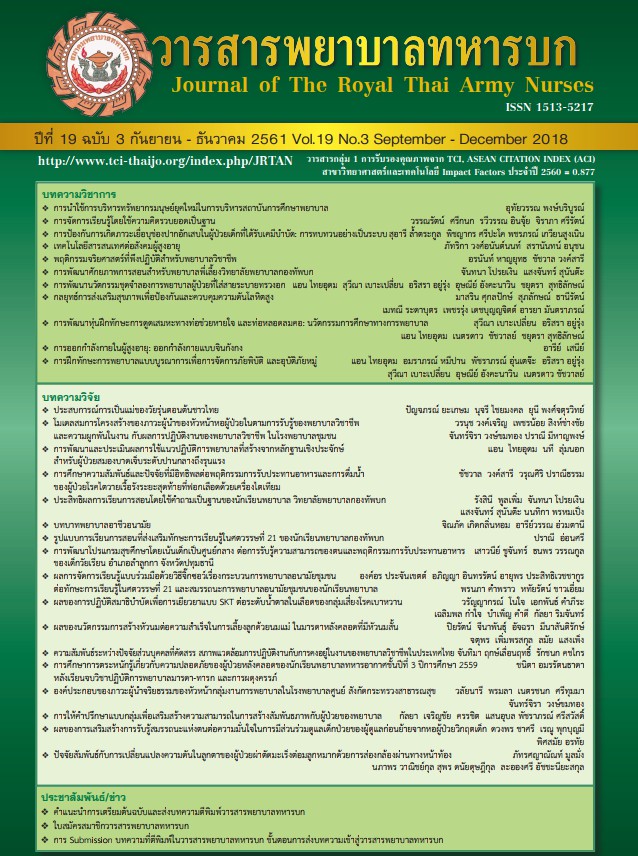The Structural Equation Model of Leadership of In-Patient Unit Head Nurses as Perceived by Professional Nurses, Nurses’ Work Engagement, and Job Performance of Professional Nurses in Community Hospitals
Keywords:
Job performance, leadership, q, Work engagement, Head Nurses of In-Patient Unit, Community HospitalsAbstract
The purposes of this analytical research design were analyzed structural equation model of job performance of in-patient unit professional nurses in community hospitals. The samples were 314 professional nurses, selected by proportionate stratified random sampling. The research instruments comprised of parts; Multifactor Leadership Questionnaire (MLQ), Utrecht Work Engagement Scale-9 (UWES-9) and Job performance questionnaire. There Cronbach’s alpha coefficient were 0.947, 0.872 and 0.962 respectively. Data were analyzed descriptive statistics and Structural Equation Modeling. The findings of this research study revealed that leadership of in-patient unit head nurses and work engagement had positive direct effects on job performance (β = .14, .48, p<.05, <.001) and had a positive direct effect on work engagement (β = .53, p< .001). The structural equation model of job performance of professional nurses was congruent with the empirical data (Chi-square = 8.969, df = 8, Probability level = 0.345, CMIN/DF = 1.121, GFI = 0.992, AGFI = 0.972, SRMR = 0.006, RMSEA = 0.020). The model accounted for 32% of the variance in job performance of professional nurses and a substantial proportion of the variance of the mediating variables. These findings indicate that, which was the nurse administration should put on the emphasis curriculum in the preparation of head nurses of nursing organization to possess both transformational leadership and transactional leadership which will enhance their work engagement. These will affect nurses’ performance.
Downloads
References
2. Office of the Civil Service Commission. Civil service act B.E. 2008. 2008. (in Thai)
3. Khunthar A. The impacts and solutions to nursing workforce shortage in Thailand. Journal of Nursing Science. 2014; 32(1):81-90. (in Thai)
4. Bogaert PV, Peremans L, Heusden DV, Verspuy M, Kureckova V, Cruys ZV, Franck E. Predictors of burnout, work engagement and nurse reported job outcomes and quality of care: a mixed method study. BMC Nursing. 2017; 18:1-14.
5. Rogers AE, Hwang W-T, Scott LD, Aiken LH, Dinges DF. The working hours of hospital staff nurses and patient safety. Health affairs. 2004; 23(4):
202-212.
6. Jyoti J, Bhau S. Impact of transformational leadership on job performance: Mediating role of Leader-member exchange and relational identification. SAGE Open. 2015; 5(4):1-13. DOI: 2158244015612518.
7. Gordon HJ, Demerouti E, Bipp T, Le Blanc PM. The job demands and resources decision making (JD-R-DM) model. European Journal of Work
and Organizational Psychology. 2015; 24(1): 44-58. DOI: 1359432X.2013.842901.
8. Bass BM. Bass and Stogdill’s handbook of leadership: Theory, research and managerial applications. New York: Free Press. 1990.
9. Schaufeli WB, Bakker AB, Salanova M. The measurement of work engagement with a short questionnaire. Educational and Psychological Measurement. 2006; 66:701-716.
10. Greenslade JH, Jimmieson NL. Distinguishing between task and contextual performance for nurses: development of a job performance scale. Journal of Advanced Nursing. 2007; 58(6):602-611.
11. Krejcie RV, Morgan DW. Determining sample size for research activities. Educational and psychological measurement. 1970; 30(3): 607-610.
12. Meehanpong P, Luangamornlert S, Changmai S. A causal model of patient unit performance in general hospital under ministry of public health. Journal of The Royal Thai Army Nurses. 2015; 16:78-86. (in Thai)
13. Kittimanont H. A causal model of health professional personnel performances in the university hospitals in Thailand (Doctoral dissertation). Hospital management, Christian University. 2014. (in Thai)
14. Hair J, Black W, Babin B, Anderson R. Multivariate data analysis. (7thed.). Pearson Prentice Hall. 2010.
15. Salanova M, Lorente L, Chambel MJ, Martınez IM. Linking transformational leadership to nurses’ extra-role performance: the mediating role of self-efficacy and work engagement. Journal of Advanced Nursing. 2011; 67:2256-2266.
16. Devi VR, Narayanamma PL. Impact of leadership style on employee engagement. Pacific Business Review International. 2016; 1(1):91-98.
17. Saks AM. Antecedents and consequences of employee engagement. Journal of Managerial Psychology. 2006; 21(7): 600-616.
18. Jankingthong K, Rukkhum S. Factors affecting job performance: A review of literature. Silpakorn University Journal of Social Sciences, Humanities, and Arts. 2012; 12:115-127.
19. Matula P, Uon VA. Causal relationship model work engagement affecting organizational citizenship behavior and job performance of professional nursing. Middle-East Journal of Scientific Research. 2016; 24:1600-1605. (in Thai)
20. Rattikarnsuka J, Oumtanee A. Nursing management of head nurses receiving the outstanding award. Journal of The Royal Thai Army Nurses. 2014; 16:179-186. (in Thai)
21. Chaleoykitti S, Kamprow P, Promdet S. Patient safety and quality of nursing service. Journal of The Royal Thai Army Nurses. 2014; 15:66-70.
(in Thai)
Downloads
Published
How to Cite
Issue
Section
License
บทความหรือข้อคิดเห็นใดใดที่ปรากฏในวารสารพยาบาลทหารบกเป็นวรรณกรรมของผู้เขียน ซึ่งบรรณาธิการหรือสมาคมพยาบาลทหารบก ไม่จำเป็นต้องเห็นด้วย
บทความที่ได้รับการตีพิมพ์เป็นลิขสิทธิ์ของวารสารพยาบาลทหารบก
The ideas and opinions expressed in the Journal of The Royal Thai Army Nurses are those of the authors and not necessarily those
of the editor or Royal Thai Army Nurses Association.






